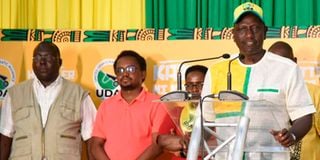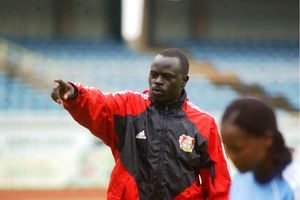Premium
The hits and misses for DP William Ruto in UDA polls

Deputy President William Ruto (right) addressing journalists at the Hustler Centre in Nairobi on April 14, 2022 on the day his party, UDA, went into the primaries on Thursday hoping to showcase its popularity, especially in Rift Valley and Mount Kenya.
Deputy President William Ruto’s party, United Democratic Alliance (UDA), went into the primaries on Thursday hoping to showcase its popularity, especially in Rift Valley and Mount Kenya. With such expectations and knowing that his opponents were waiting for any slight stumble, the party performed largely above average.
The nominations revealed the DP’s strengths and weaknesses. The strengths include popularity of the party, ability to renew itself by attracting young candidates, growing organisation skills and the strongholds.
But the primaries also served as a reminder of the hurdles he has to overcome to win the presidential race in the August 9 General Election. Among them are low voter turnout in areas like Mt Kenya, loss of bigwigs that may bring in cash and clout, the lack of cash needed to man votes in an election and the unreliability of some of the youth vote that identify with the "hustler nation".
Taken personal charge
In organising the UDA polls, the DP had taken personal charge of the exercise which ensured that failures were limited. On the other hand, Azimio presidential hopeful Raila Odinga left the ODM nominations to the party’s National Elections Board making it easy for incumbents to infiltrate the system and subvert the peoples' will, a scenario that has seen all MPs re-elected in Mr Odinga's strongholds of Siaya and Homa Bay counties.
While UDA’s NEB chairperson Anthony Mwaura and Tharaka Nithi senator, Prof Kithure Kindiki, provided updates on the nomination throughout the day on Thursday, Mr Ruto appeared late in the evening to give the final word, further showing how he was keen on delivering clean primaries.
"I applaud the National Elections Board (NEB) for the nomination that has been successful. We experienced challenges in some areas which will be investigated and if necessary, the polls might be repeated," Dr Ruto said.
Except in Rift Valley which is his backyard, the DP had tried to ensure consensus prevailed in most other areas, what again lowered temperatures. The primaries, therefore, gave a chance for fresh blood to reinvigorate the party as big names fell by the way side. But in doing so, it may have taken away some of the trusted allies of the DP such as former Devolution Cabinet Secretary Charles Keter and Soy MP Caleb Kositany. In particular, Mr Keter has been a trusted ally and an asset to the DP in terms of fundraising, mobilisation and his influence. Moreover, some of these allies who lost have a nationwide name recognition which is important for mobilisation.
For his hands-on management of the primaries, the DP ensured that the exercise went on smoothly in most parts.
Not as excepted
Even though UDA says that it has some eight million registered members who were eligible to vote in the primaries, the turnout was not as excepted.
Traditionally, turnout in party primaries, like in by-elections, is usually not as high as in the General Election but given the UDA's intention was to show how popular the party is, low voter participation blighted the otherwise smooth exercise.
But it is in the turnout that the DP will have to go an extra mile to improve on ahead of the August polls. By using the IEBC register, the party opened up for even none members to vote in the primaries but still, the turnout, particularly in the mountain region, was less impressive.
Given that the DP’s core bases are his backyard of Rift Valley and the mountain, anything that affects the turnout in the regions in the General Election will hugely impact on his State House bid.
In both Rift Valley and Mount Kenya where UDA has put a concerted effort to dislodge President Uhuru Kenyatta's Jubilee Party, turnout was very low.
Analysis of governor races in Jubilee Party 2017 nominations compared to those of the just-concluded UDA nominations indicate that Ruto has a tough job ahead.
For instance, Kiambu which in 2017 had 1.2 million registered voters only saw 138,384 people participate in the governor nomination unlike in the battle between Ferdinand Waititu and William Kabogo which attracted over 423,520 voters. According to the latest vote-listing by IEBC, Kiambu has 1.3 million registered voters.
Delayed poll opening
In Gatundu South and Kiambaa constituencies, low turnout and delayed opening of polling stations characterised the process.
Another justification that UDA primaries witnessed low turnout is Uasin Gishu. In 2017, some 209,550 people voted in the governor nomination unlike this time where only 179,970 participated.
In Nakuru County, the primaries which were supposed to be high-octane recorded a poor turnout across all the 11 constituencies.
Subukia constituency, which is considered an UDA stronghold, had 18,690 people vote out of the 81,144 registered.
In the neighbouring Bahati constituency whose MP Kimani Ngunjiri is Ruto's close ally, the turnout was even worse. The agriculture-rich constituency has 100,508 registered voters but only 13,684 voters turned up to vote in the primaries.
With Jubilee planning to field candidates in the polls in all the 11 constituencies, this means UDA must work even harder to win most of the parliamentary seats in Nakuru that has a combined 1.1 million registered voters.
The nominations started slow in many parts of Murang'a County. Officials were claiming that overnight rains delayed the turnout. Nearly three hours after the polls had opened, only 10 people had cast their ballots at Kagunduini Primary School.
In Nyeri, most polling stations had served less than 100 voters by midday. In Meru, there was poor turnout after incumbent MCAs and the Woman representative aspirants failed to take part in the nominations.
Ballot materials burnt
In Embu, the turnout was affected after the nominations were delayed for several hours to enable the replacement of ballot materials burnt during the Wednesday fracas.
In Tharaka Nithi, voters were stranded after voting started late due to missing materials and disagreements over the reorganisation of presiding officers.
Some voting materials for the Maara constituency were still in Tharaka constituency by 10am causing an uproar among aspirants and voters.
Given that Mr Ruto is facing steep climbs in other regions like Nairobi, Coast, Western, Nyanza, Lower Eastern and North Eastern, he needs a high turnout in Rift Valley and the mountain region to better his chances of winning the presidency in the August 9 polls.
Hurdles to surmount
According to Prof Masibo Lumala of Moi University, with low turnout largely witnessed in Mount Kenya unlike in Rift Valley, UDA has some hurdles to surmount ahead of the elections.
"On one hand, it is now clear that Rift Valley is an UDA zone and that is why those who have won tickets are sure of winning the August elections. The voter turnout will worry UDA in areas like Nyeri, Embu, Kiambu and the likes meaning the masses are not yet convinced," Prof Lumala elucidated.
The poor turnout is also giving his opponents ammunition to claim that UDA is not as popular in the mountain as the DP and his allies have portrayed it. In Nyandarua County, for instance, Governor Francis Kimemia attributed the low voter turnout to a reinvigorated Jubilee.
"The party activations and direct involvement of the President are bearing fruit; voters are realising the truth. The time for lies has come to an end. We have a shocker for them in the remaining months. They should prepare for a saddening defeat,” said Mr Kimemia as he mocked UDA for the poor turnout in his county.
The party chose to use the 2017 voters’ register by the Independent Electoral and Boundaries Commission (IEBC), which according to Murang’a Senator Irungu Kang’ata, could have locked out many eligible voters whose names were not in the register but were registered as UDA members.
“Remember UDA didn't allow new voters to vote unlike 2017 when we had a full register. Anyone who had taken a voter’s card after 2017 could not vote. We didn't have an updated IEBC register,” said Mr Kang’ata.
Mr Kang’ata also disagrees that the turnout was low.
“I am saying the turnout was very good. I guess the media wanted to see lines as evidence of a huge turnout. There were lines but also efficiency that ensured there were no queues. You need data to conclude turnout was low,” he said.
According to the Murang’a senator, the 2017 and 2022 Jubilee and UDA nomination numbers are not far apart.
In Nyandarua, he says about 120,000 people voted which is almost similar to the 2017 figures.
“Kimemia got 87,000 votes in 2017 (Jubilee nominations). The winner in this race got 60,000 or thereabouts. That is comparable,” said Mr Kang’ata.
Exogenous factors
In places where turnout was not impressive, Mr Kang’ata claims it was because of exogenous factors other than support for UDA.
“Remember we had transportation challenges due to fuel crisis,” he said.
Nyandarua County Assembly Majority Leader Mukuria Sambigi expressed similar sentiments, saying Jubilee has the structures and growing goodwill from the people.
"The UDA politicians were misguided that they have the majority, but the voter turnout speaks loud and clear,” said Mr Sambigi, the Githioro ward MCA.
While Rift Valley appears to be safe as far as turnout is concerned, the challenge for the DP will be the mountain region.
Reports suggest that the DP will name his running mate from the region. Such a move, he hopes, will cement his pact with the region and motivate voters to come out and vote on August 9.
Insiders now say the battle for the running mate has been reduced to four people: Kandara MP Alice Wahome, Mathira MP Rigathi Gachagua, Prof Kindiki and Kiharu MP Ndindi Nyoro. Though the battle seems to have reduced to the latter two, insiders say all four have an equal chance in DP Ruto’s eyes.
Additional reporting by Francis Mureithi, Simon Ciuri and David Muchui.






